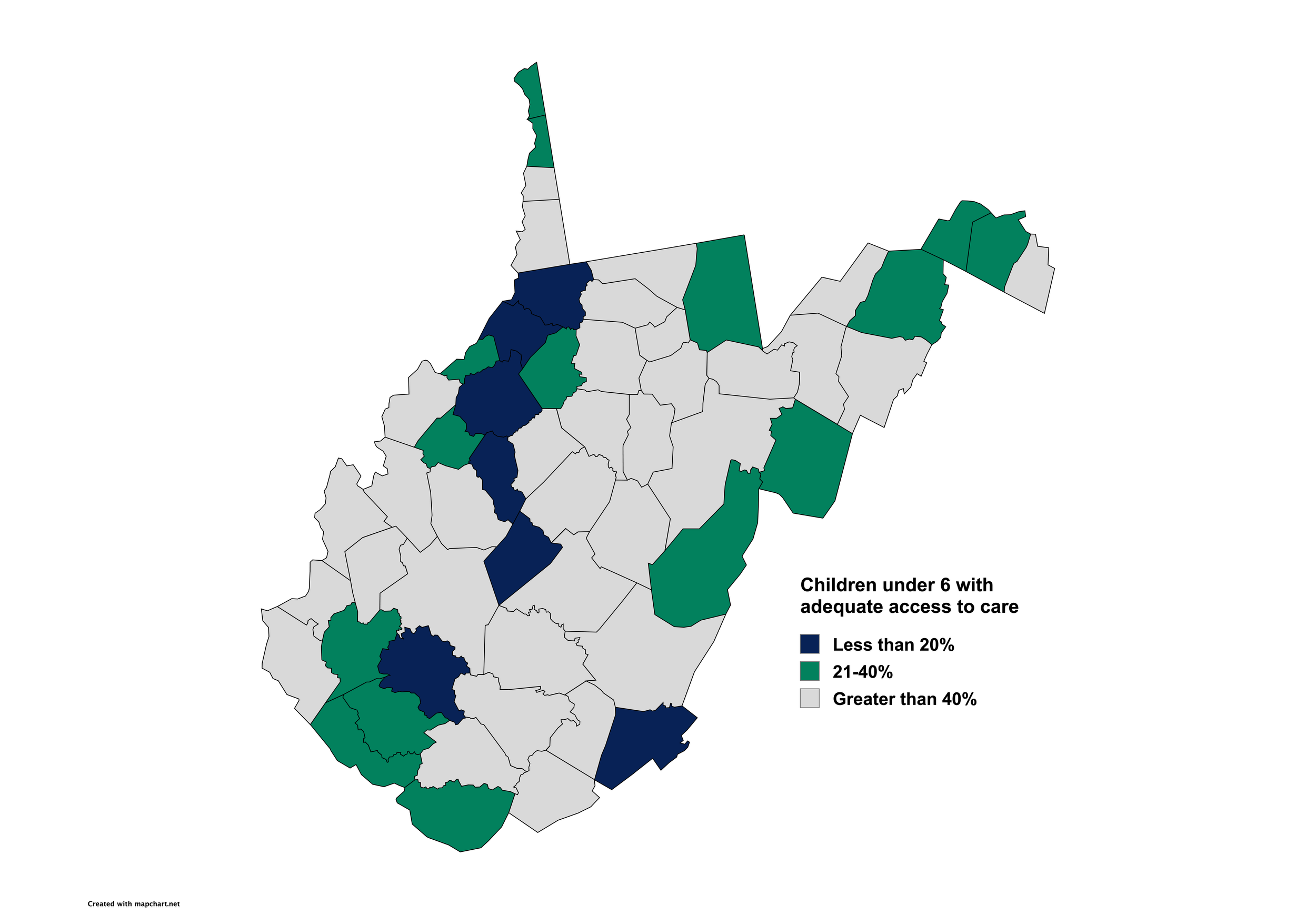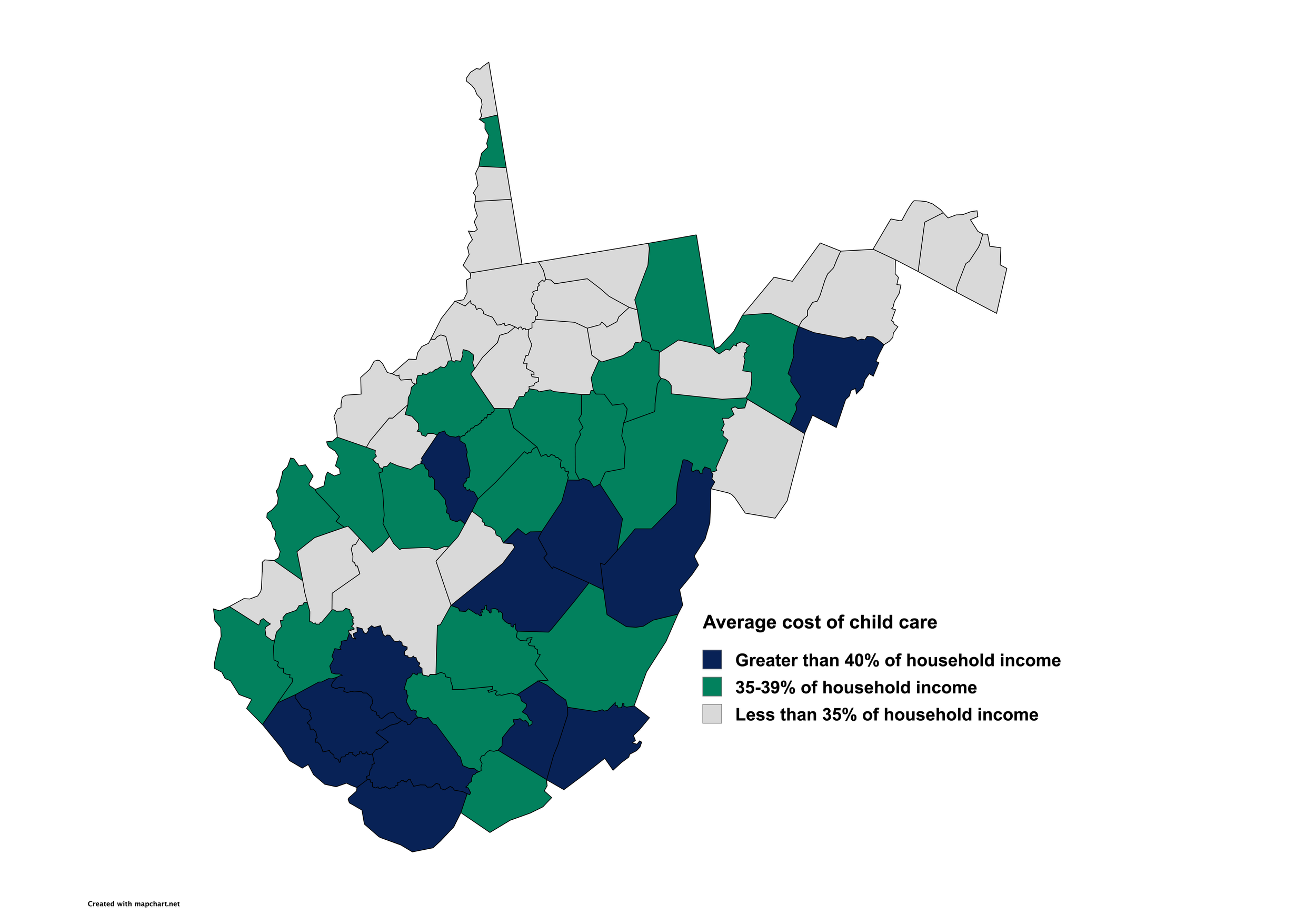
West Virginia Child Care
Child care has been shown to help children develop essential skills and help economic development by providing care so parents can work; however, cost and access remain a problem for many families in West Virginia. This Science and Technology Note explores child care availability and funding mechanisms, as well as strategies other states are using to help families afford child care.
Research Highlights
Over 26,000 West Virginia children do not have access to child care.
Families in West Virginia pay an average of 25% of household income on childcare.
West Virginia recently clarified that child care providers will be reimbursed based on attendance, not enrollment, causing concern that they will lose revenue.
West Virginia is the only state in the region to offer universal preK to all 4 year olds.
Some states, including Kentucky, passed Tri-Share legislation to help families afford care.
Child care has been shown to help children develop essential skills and help economic development by providing care so parents can work; however, cost and access remain a problem for many families in West Virginia. This Science and Technology Note explores child care availability and funding mechanisms, as well as strategies other states are using to help families afford child care.
What is Child Care?
Child care involves a care provider taking care of multiple children outside of the child’s home. There are three primary types of child care: family child care, child care centers, and school age programs. These programs generally require the provider to be licensed unless the provider is regulated by another state entity, such as school-based care, or is only part-time, like a faith-based nursery during a religious service. In addition to child care facilities, early education opportunities are available for children 3-5 years old, including prekindergarten (preK) programs.
| Type | Group Size | Location | License Required | Example | Number of Providers in WV |
|---|---|---|---|---|---|
| Family Child Care | Small | Caregiver's home | Yes | Home-based child care | 756 |
| Child Care Center | Large | Classroom in facility | Yes unless only operating part-time | Day care center | 312 |
| School Age Program | Large | School or in the community | Yes if not regulated by another entity | After school care | 86 |
Child care provides opportunities for both parents and children. Access to child care is an important factor for boosting economic development, as it allows parents to work while their children are cared for. By having reliable child care, parents can commit to a work schedule and reduce absenteeism. It can also benefit communities by providing staff training and jobs. Being around other children is beneficial for children by helping them to better develop emotional, behavioral, and social skills than children not in child care programs.
Child Care Availability in WV
Child care is a growing need in West Virginia; however, access is declining. In October 2023 there were 1,412 licensed providers, which decreased to 1,251 in October 2025. Reductions were seen across all programs except Head Start, the most drastic being a 16% decrease in family child care providers. There are about 61,500 children under 6, with over 26,000 unable to access child care. Lack of access is largely due to capacity limits and costs, but is also notable in rural parts of the state and could also be due to transportation issues. Without child care, generally one parent leaves the workforce, rearranges work schedules, or ask family for assistance.
Child care access map in West Virginia. Based on data from Mapping the Gap.
Costs of Child Care
Child care is a costly expense for most Americans, including West Virginia families. The US Dept of Health and Human Services considers child care to be unaffordable if it costs more than 7% of a household’s income. On average, West Virginia families pay about 25% of their household income on childcare, which is less than the average national of 34% of household income. These costs vary across the state but can be more than 40% of household income in some areas.
Average cost of child care in West Virginia. Based on data from the County Health Rankings.
The Child Care Development Fund (CCDF) is the largest federal child care subsidy program. The CCDF provides subsidies for licensed child care; if the child is younger than 13, at least one parent is working or in school, and the household income is less than 85% of the state’s median income ($49,229 in 2023). CCDF funds are paid directly to the provider from the state. Since 2020, DoHS has paid providers based on enrollment, but recently clarified eligibility to be in line with federal rules and the DoHS Child Care Manual. The rules will reimburse providers based on attendance, meaning that a child must be in care for at least 4 hours for full reimbursement. DoHS has said most providers will not be impacted, but providers are voicing concern that many will lose revenue, as many children do not stay for a full 4 hours, possibly because some only attend for after-school care for a short time. They argue that reimbursement should be based on enrollment. Because providers must maintain certain child:staff ratios (which vary based on the center and age of children), some worry that revenue loss may lead to staff layoffs, decreasing the number of children they can care for. Two options to decrease costs were SB 373 and HB 5051 (2024), which would have provided tax credits to child care facilities, however neither made it out of committee.
One feature unique to West Virginia in the region is the state’s preK program. West Virginia offers universal preK to 4 year olds and some 3 year olds with special needs. This is different from Virginia and Maryland, which have income limits for state-sponsored preK; and Ohio and Kentucky, which do not offer preK at all. In the 2023-2024 school year, over 13,000 4 year olds were enrolled in state-sponsored preK, making West Virginia 4th in the nation for enrollment.
Additional federal and state financial programs are in place to help families. Head Start is a federally-funded program that subsidizes child care for children under 5 from families whose income is below the federal poverty limit ($32,150/year for a family of 4). West Virginia passed HB 2026 (2025), appropriating about $9 million for child care. The DHS, however, estimates $35 million is needed to fully fund child care subsidy programs.
State Child Care Legislation
In light of the recent rule clarification, there are several strategies that could alleviate concerns in West Virginia. The state could seek options to entice employment opportunities at child care centers, including hiring bonuses or pay increases. West Virginia could also seek to provide child care workers subsidies for free child care for their own children, similar to a Kentucky program, however this may impact the amount of available spots open for other children, as staff’s children would also contribute to the child:staff ratio requirements.
West Virginia has legislation to assist parents seeking child care. SB 656 (2022) provides a tax credit to companies with child care options, also helping them attract employees with children. However, this largely helps larger employers. To help other families, Michigan, North Carolina, and Kentucky implemented Tri-Share programs, which splits the cost of child care between the family, employer, and state. A similar program was proposed in 2024 (HB 5293), but did not make it out of committee. West Virginia could continue to explore this option; though financial considerations should be taken into account. A fiscal study found that this type of program would cost the state at least $421,000 for 100 children. Considerations for the family should also be taken into account, if child care is tied to an employer, it may make it difficult for a parent to change jobs if needed.
This Science and Technology Note was prepared by Nathan G. Burns, PhD, West Virginia Science & Technology Policy Fellow on behalf of the West Virginia Science and Technology Policy (WV STeP) Initiative. The WV STeP Initiative provides nonpartisan research and information to members of the West Virginia Legislature. This Note is intended for informational purposes only and does not indicate support or opposition to a particular bill or policy approach. Please contact info@wvstep.org for more information.

